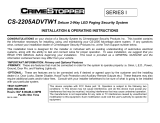
© 2008 Directed Electronics—all rights reserved
6
Warning! Safety rst
The following safety warnings must be observed at all times:
Due to the complexity of this system, installation of this product must only
be performed by an authorized Directed Electronics dealer.
When properly installed, this system can start the vehicle via a command
signal from the remote control Therefore, never operate the system in an area
that does not have adequate ventilation. The following precautions are the
sole responsibility of the user; however, authorized Directed Electronics dealers
should make the following recommendations to all users of this system:
Never operate the system in an enclosed or partially enclosed area without
ventilation (such as a garage).
When parking in an enclosed or partially enclosed area or when having
the vehicle serviced, the remote start system must be disabled using the
installed toggle switch.
It is the user's sole responsibility to properly handle and keep out of reach
from children all remote controls to assure that the system does not unin-
tentionally remote start the vehicle.
USER MUST INSTALL A CARBON MONOXIDE DETECTOR IN OR ABOUT THE
LIVING AREA ADJACENT TO THE VEHICLE. ALL DOORS LEADING FROM
ADJACENT LIVING AREAS TO THE ENCLOSED OR PARTIALLY ENCLOSED
VEHICLE STORAGE AREA MUST REMAIN CLOSED AT ALL TIMES.
Use of this product in a manner contrary to its intended mode of operation
may result in property damage, personal injury, or death. Except when performing
the Safety Check outlined in this installation guide, (1) Never remotely start the
vehicle with the vehicle in gear, and (2) Never remotely start the vehicle with
the keys in the ignition. The user will be responsible for having the neutral
safety feature of the vehicle periodically checked, wherein the vehicle must not
remotely start while the car is in gear. This testing should be performed by
an authorized Directed Electronics dealer in accordance with the Safety Check
outlined in this product installation guide. If the vehicle starts in gear, cease
remote start operation immediately and consult with the user to fix the problem
immediately.
1.
2.
3.
4.




















